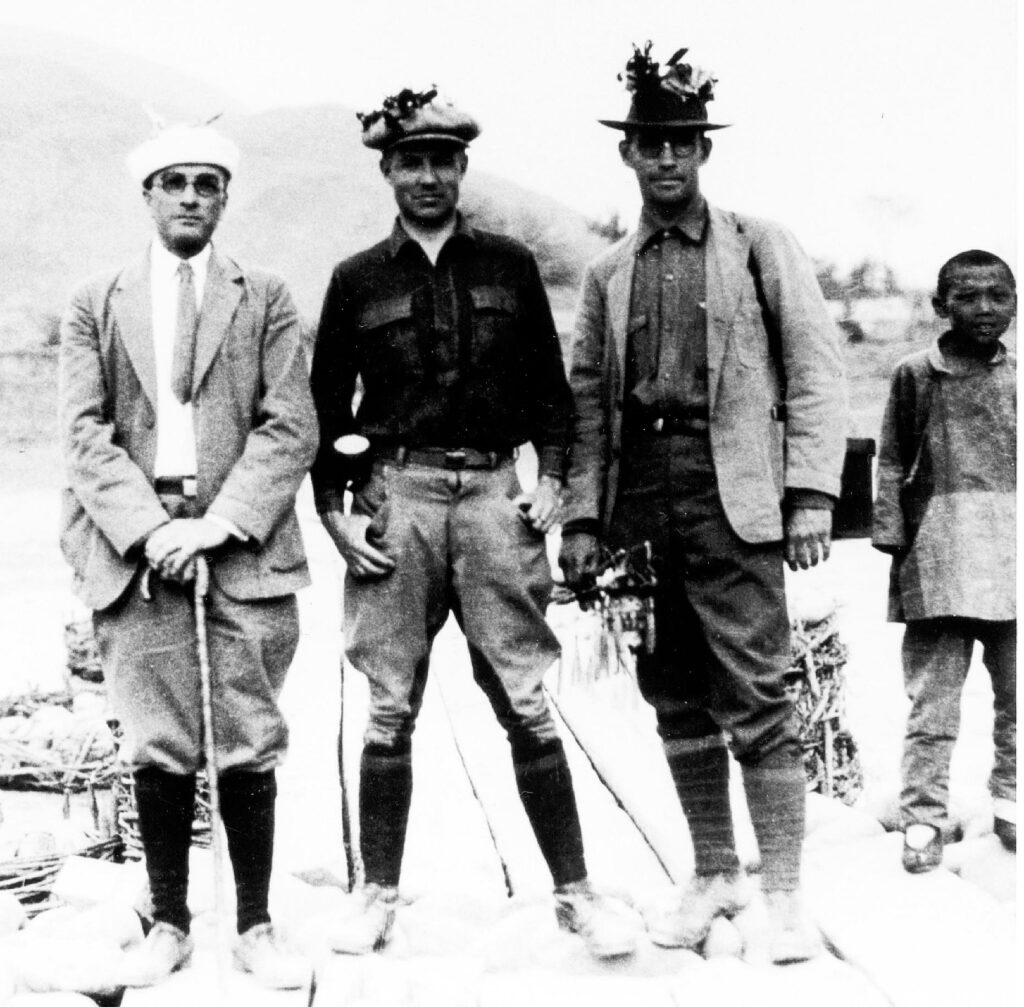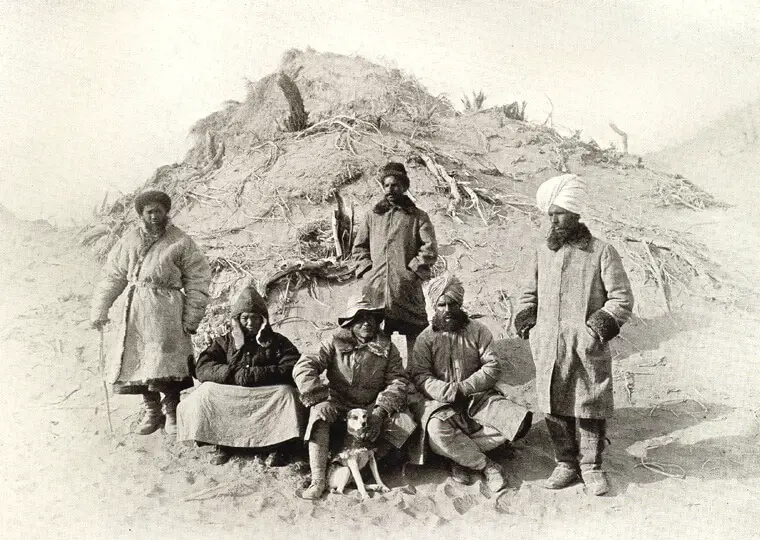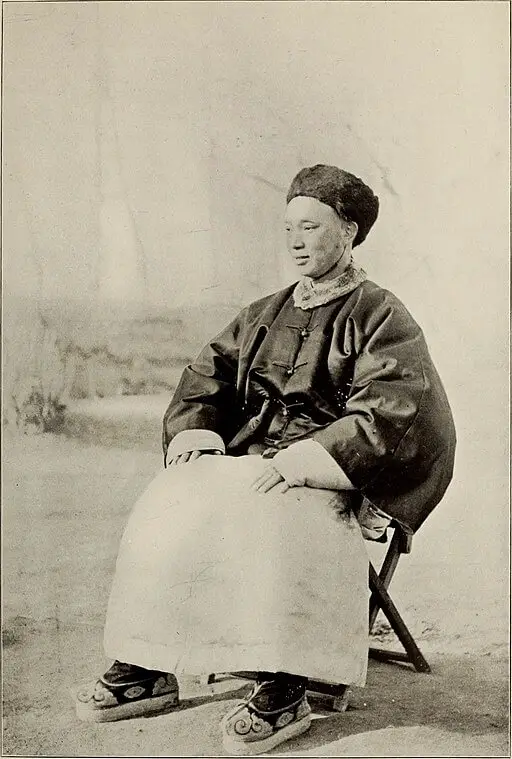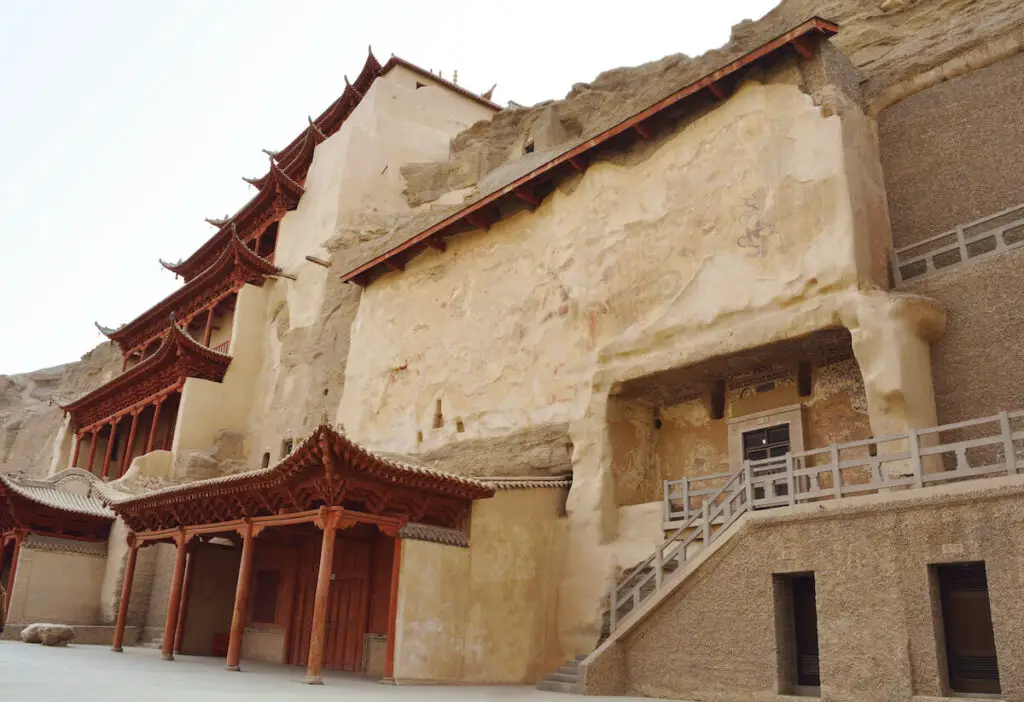This article deals with the long Overland route from north-east China to Chinese Turkestan (now Xinjiang) to Persia and Asia Minor. It was the route by which Chinese pilgrims made their way to India in search of Indian philosophy and wisdom. Marco Polo traveled it about A.D. 1272 when he set out to the court of the Great Khan.

China’s Old Silk Road’s Early History
As early as the second century B.C. China made vigorous efforts to keep this road open; for from time to time it was obstructed by nomadic central Asian tribes. The common notion that China was always bent on isolation from the west is only partly true. It was mainly after A. D. 1510, when the Portuguese, the Dutch, and finally the English pushed into Southeast Asia that China adopted an isolationist policy.
in the year 138 B.C., during the Han Dynasty, Emperor Wu sent an envoy to the Central Asian tribes to negotiate – notably with the Xiong-Nu (Hsiung-nu) – about opening the road to the west. This envoy, after being held prisoner for ten years, managed to reach what is now Iran. He had traveled westward from China, a distance of nearly 40° latitude, and took back to his homeland new information about the West, and also plants previously unknown to China.
China’s ancient capital in the northeast, then known as Ch’ang-an (now Xian) was the starting point for all who took the westward journey. Here pack animals and camel trains were outfitted. Travelers took turns riding or walking beside their mounts. After some twenty marches into China’s northwest panhandle, they reached the terminus of the Great Wall.
Here was the town of Dunhuang (Tun-Huang) established as a garrison post in A.D. 111. Dunhuang was a division point where two routes were available for the westward march along the forbidding Taklamakan Desert to Samarkand or Kashgar. “West of Dunhuang,” says an eighth-century Chinese Poet, “you will meet with no old friends.”
Sir Aurel Stein of the Indian Archaeological Survey called this desert:
“probably the most formidable of a the dune-covered wastes of the globe.”
Sir Aurel Stein
Stretching about 900 miles from east to west and 300 miles from north to south, it is hemmed in on the north by the Tian Shan (T’ienshan) range and on the south by the snow-covered Kunlun mountains of Tibet.
Caravans could skirt the desert either along the northern rim, which however was exposed to bandits or along the southern rim which had only a few cases watered by flash floods from the mountains. In the intervening stretches, no water or grazing was available. Water for men and animals was often carried as ice.
The only guide marks above the dunes were the bleached trunks of dead trees, or the posts of abandoned dwellings rising above the sand like masts of sunken ships. So fraught with hazards was this journey that caravan men greeted each other with the Turkish expression:
Yol bolsum, “May there be a way.”
Ancient Silk Fabric Discoveries and The Old Silk Road
Silk originated in China long before the Christian era and was mentioned by Aristotle in Greece. It is perhaps the foremost of China’s gifts to the West.
By 106 B.C. the Silk Road to Persia and Syria was established. That it was properly so named, is confirmed by finds of actual bolts of silk in the dry desert sands. The afore-mentioned Sir Aurel Stein uncovered a bale of silk from the Han period, of the kind that found its way to Rome. Such bales were usually nineteen inches wide and had a length of forty and fifty feet.
Although China’s interest in Indian thought began with the introduction of Buddhism about A.D. 65 or slightly earlier, the first written record of a Chinese going to India for study dates about A.D. 259. For nearly a thousand years Chinese students traveled the desert road until it was obstructed by the spread of Islam into Central Asia.
Their search was both intellectual and religious. They longed for life-enhancing ideas that would give to their own more mundane Confucian ethics a cosmic metaphysical sanction. They were the forerunners one may say, of the many Chinese students who in our time have made their way to Europe and America to acquire the science, politics, and philosophy of the West.
Early Chinese Students Travel The Old Silk Road
Some years ago one of China’s most distinguished historians and essayists, Liang Qichao (Liang Ch’i-ch’ao) made a preliminary study of these early pilgrimages to India. The title of his easy, which put into English reads: “Chinese Students Who Studied Abroad Fifteen Hundred Years Ago.”
Liang Qichao could not, of course, identify them all. But, of nearly 200 names he encountered, he found that fourteen started out, but came back without reaching their goal; thirty-one died on the way; five died on the homeward journey; six made the journey once and went to India a second time; eighty started out but were not heard from again. One student was in India for more than forty years; another for more than thirty years; and another for more than twenty years.
It was a journey that called for perseverance hardly imaginable in our day. After reaching one of the two halting points – Kashgar or Samarkand – they headed south over the Pamirs, called by the natives the Roof of the World. Others crossed the Hindu Kush overpasses 15,400 feet high. After surmounting these barriers, they entered India by way of Afghanistan.
These travelers carried back to China, after years of study, a new and richer outlook on life. They translated the Indian scriptures into Chinese; opened up subline vistas of man’s place in the universe; created new forms of literature history and art.
They inspired the building of restful temple structures on choice mountain sites. In these quiet retreats, people of all stations in life could find at small costs temporary release from the contradictions and vexations of the duty world.
Chinese Pilgrim Faxian Collects Religious Texts Using The Old Silk Road
The first Chinese pilgrim to leave a notable account of his journey to India was Faxian (Fa-hsien) who is best known by his religious name. He set out from Ch’ang-an (Xian) in A.D. 399. Crossing the great desert and the Pamira, he through more than thirty kingdoms.
After collecting religious texts which he later translated, he went to Sri Lanka (Ceylon), and from there returned to China by sea. He had been away from his homeland for fifteen years.
The account of his travels, translated by H.A. Giles, is called Record of Buddhistic Kingdom. Of the desert crossing and its folklore, he had this to say:
“There are many evil spirits and also hot winds; those who encounter them perish to a man. There are neither birds above or beasts below. Gazing on all sides as far as the eye can reach inorder to mark the track, no guidance is to be obtained save form the rotting bones of dead men which point the way.
Faxian – Record of Buddhistic Kingdom
Xuanzang Travels The Old Silk Road To Seek The Law of Buddha
Another traveler who, more than any other has captured the imagination of both Chinese and westerners and has left the most detailed account, was Xuanzang (Hstian-tsang – again to use his Buddhist name. After searching out in China all the Buddhist enlightenment he could get, he sets out secretly from Xian (Ch’ang-an) at the age of twenty-nine, in A.D. 629.
He declared his purpose in these words:
“I covet neither fame nor wealth. My sole aim is to seek the Law of Buddha.”
Xuanzang
On his outward journey, he followed the northern rim of the desert to Samarkand. From there he pressed south over the Hindu Kush to Kabul, and finally to Kashmir.
A modern Chinese scholar, Chang Kuei- sheng, (see Chinese Culture, January 1958, pp. 86-123) estimates during his fifteen years in India Xuanzang traveled over 40,000 miles, not counting detours and visits to distant places.
He collected over 657 religious texts in the Sanskrit language and returned to Dunhuang (Tunhuang) and Xian (Ch’ang-an) along the southern edge of the desert. In the last nineteen years of his life, he and his assistants translated into Chinese more than seventy scriptures of the idealistic Mahayana school.
Xuanzang belongs to those rare figures in history who – once you have made their acquaintance – you can never forget. For he combined to an unusual degree superior intellectual attainment with high spirituality.
Religious Silk Road Travelers Who Traveled The Old Silk Road West To East
Let us turn to travelers who made the desert crossing the opposite – from west to east. Among them were the Manicheans from far off Persia. Their foothold in China lasted a while and then disappeared.
At the same time, there were Christians of the Nestorian sect who came to China, first perhaps as merchants. in A.D. 635, and stayed there to carry on their Christian worship for more than 200 years. In A.D. 781 they erected in the capital city Xian (Ch’ang-an), an imposing stone monument, still standing that tells of their history.
Similarly, there came from the West a colony of Jews who for nearly nine hundred years lived and practiced their faith in Kaifeng, the long-time capital in Central China on the Yellow River. Several of their monuments state that they built a synagogue in Kaifeng in A.D. 1163.
There, until about 1850, they carried on their Hebrew worship unmolested, and read their scriptures in Hebrew. Six rolls of Pentateuch, which they used, are now preserved in London.
Marco Polo Travels The Old Silk Road
Surely the most celebrated European to travel the desert road in medieval times was Marco Polo, who at the age of six set out first with his father and uncle in about 1270s along the southern rim and, life travelers before him, wrote about with animation of his experiences:
“There is a marvelous thing related to this desert which is that when travelers are on the move by night, and one them chances to lag behind or fall asleep … when he tries to gain his company again he will hear spirits talking, and will suppose them to be his own comrades. Sometimes the spirits will call him by name; and thus shall a traveler oft-times be led astray so that he never finds his party … Sometimes the stray traveler will hear as it were the tramp and hum of great cavalcade of people away from the real line of roada and taking this to be their own company they will follow the sound and when day breaks find that a cheat has been put on them and that they are in an ill plight. Even in the daytime one hears those spirits talking. And sometimes you hear the sound of a variety of musical iinstruments and still more commonly the sound of drums. Hence in making this journey ’tis customary for travelers to keep close together. All the animals too have bells at their necks, so that they cannot easily get astray. And at sleeping time a signal is put to show the direction of the next march. So thus it is the desert is cross.”
Marco Polo (translated in Henry Yules: The Book of Ser Marco Polo, Vol I, Page 197)

Sir Aurel Stein – Old Silk Road Explorer
We are indebted to Sir Aurel Stein, of the Indian Archeological Society for reviving in modern times an interest in the Old Silk Road. In that capacity, he understood to follow, from west to east, the desert tracks of Marco Polo and of the seventh-century pilgrim, Xuanzang who he calls:
“My Chinese pilgrim guide.”
Sir Aurel Stein in refering to Xuanzang
Stein’s books make good reading, for example, “Ruins of Desert Cathay” (1912) and “On Central Asian Tracks” (1933). His English style is faultless, which is all the more noteworthy in the view of the fact that he was a Hungarian by birth.
Setting out from India in the fall of 1906 on his second expedition, Stein crossed the Hindu Kush to Kashgar. There he engaged a Chinese secretary named Chiang Ssu-yeh without whose assistance he could not have interpreted the ancient writings that the two of them later uncovered in the desert.
Pressing towards Dunhuang they followed the southern rim of the desert. Halting at intervals for hasty excavations at promising sites, they turned up many written documents testifying to the varied cultures that once flourished there.

Stein and Chiang’s Discoveries On The Old Silk Road
They found images of Buddha showing the influence of classical Greek sculpture; Chinese foot measures two thousand years old; medical prescriptions; woven fabrics; official correspondence; calendar for the years 63, 59, and 57 B.C; and fragments of a Chinese lexicon of 48 – 33 B.C.
From such finds, as well as from classical literature, we now know what materials the Chinese wrote before they invented paper around A.D. 105. Their earliest writing was on bone or tortoiseshell, and later on silk as the classics attest.
But silk was costly. Another medium ready to hand was what Stein called “wooden stationery” – slips of wood, commonly popular, shaped about nine inches long and three-fourths of an inch wide. The characters were written top to bottom on each slip, these slips being held together by two rows of hemp thread.
When folded into an accordion pleat and wrapped, each bundle constituted a chapter or book. Chinese books today show vertical columns of the same width- the columns being read downward and from right to left.
Some years ago a Chinese- Swedish expedition to Central Asia uncovered such a book comprising seventy-seven slips of wood, still held together by the original hemp threads. Written in the years 93-95 B.C. this document is an inventory of weapons held by a Chinese garrison in the far northwest.
it is now in Taiwan, along with some 10,000 inscribed loose slips, likewise found in the desert.

Stein & Company – The Cave Of The Thousand Buddhas
As Stein’s caravan neared Dunhuang in the spring of 1907 the western end of China’s Great Wall came into view. But here the wall is much eroded by the desert winds, only the massive watchtowers retaining their original shape. The intervening portions are reduced to low ridges of sand heaped above the plain.
From earlier travelers, and during his halt at Dunhuang, Stein heard about the Cave of Thousand Buddhas (Qianfodong or Ch’ien Fo Tung) some nine miles southwest of the city. Actually, the site consists of some 500 man-made grottoes which extend in tiers for half a mile along the side of a cliff.
They contain images of the Buddha, and frescoes in color exhibiting the life and legends associated with that saint. A stone monument in one of these caves, itself dates A.D. 698, asserts that the site was consecrated in A.D. 366.
But, what gives the site its special importance is the discovery, as we shall see, of a vast deposit of ancient manuscripts in one of the caves.
When Stein and his Chinese secretary arrived, the sole custodian of the caves was a Chinese Daoist priest named Wang Yuan-Lu who came to live there about 1900 and in lived in one of the grottoes.
Being a true Daoist, Wang had no quarrel with the Buddhist religion. Infact, he looked upon the famous Buddhist traveler, Xuanzang, as his own patron saint. For had not Xuanzang as long ago as the seventh century, visited the Caves on his way to and from India?
Wang’s hope, we are told, was to restore these caves to their ancient grandeur, as an act of piety to the great traveler. Yet, as a Daoist, he made his living selling charms and spells against illness and misfortune, to people in the neighborhood.
We are told in 1900, in the midst of his restorations, Wang detected a loose brick high on the wall where the plaster had fallen away Peering behind it, he observed a dark chamber piled some ten feet high with manuscript rolls and many loose pieces.
Later examination revealed that there were in fact some 20,000 rolls sewed up high in 1130 cloth bundles. Most of them are in Chinese, others in Central Asian languages.
The dates of the manuscripts range from A.D. 406 to 996. It is believed that around A.D. 1040, very likely a time of turmoil, the cave was sealed against robbers and then overlooked.
Before Stein’s arrival in 1907. Wang had prudently made no effort to exploit the find, for disposal by himself of individual items; it would have prejudiced his reputation in the neighborhood.
Even so, it was only after much persuasion that Wang Yuan-lu permitted Stein and his Chinese secretary to have a look at the manuscript rolls. It took three visits to the sites before the diffident priest consented to carry to their tent, at midnight, several armfuls of rolls for their inspection.
The items which Wang hoped on no account to part with were the numerous Buddhist texts which the hands of pious priests had copied on rolls of paper over several centuries. It so happened however that these were the items that Stein prized least. For, owing to the invention of printing, Buddhist texts had come down to modern times without many variations.
Stein himself wished to procure items in fields where duplicates were few: secular texts, temple banners, embroideries, and paintings on silk. With their tastes thus defined, the secretary and the preist carried to Stein’s tent for seven nights, armfuls of items preferred.
Nevertheless, Wang Yuan Lu was still uneasy. Before closing the deal he insisted on making two trips around the countryside to assure himself that no rumors of the transactions had spread abroad. His final stipulation was that the three of them were not to mention the matter until Stein had left China for India.
In his book Serindia (1921), Stein gives a rough estimate of the acquisitions that finally reached the British museum: some 3000 rolls, about 500 paintings, and embroideries, not to mention works in Sanskirt. Tibetan and other languages.
For these treasures, Wang was given sixteen ingots, amounting to 500 rupees or 183 pounds. When Stein returned to Dunhuang, seven years later in 1914, he found that the priest had rendered a full accounting for the sum received and that all disbursement had been made for the benefit of the shrines.
The Dunhuang Manuscripts of Ancient Text
From our point of view, the choicest items that reached the British Museum lies in the realm of printing. It is no other than the oldest printed book in the world: a roll of Buddhist Diamond Sutra struck off 600 years before the time of Gutenberg.
Printed in Chinese it bears at the close an inscription that reads:
Reverently made for free distribution by Wan Chieh on behalf of his two parents, on the fifiteenth of the fourth moon, ninth year of Hsien-t’ung (May 11, 868 A.D.)”
With true Buddhist universality, the donor added the hope that the merit for printing this scripture would accrue, not to himself alone, but to all living creatures.
A year later, in 1908, the renowned French specialist on China, Paul Pelliot, went to the caves and, with the eye of an expert, selected some 3000 other items which are now in the Bibliotheque Nationale. Among them is a Chinese rendering of the Christian hymn, “Gloria in Excelsis.”
At long last, in 1910, the Beijing (Peking) government ordered all the leftover manuscripts to be taken to Beijing for deposit in the National Library. In December 1948, about a year before the communists took control of the mainland, these treasures said to number 9,871 rolls – were transferred to Taiwan.
Nonetheless, not all of the Dunhuang treasures left the caves. For in 1916, a mission from Japan went to the site and obtained some 600 manuscripts which the reluctant Wang Yuan-lu had held back and had stored inside a newly -consecrated image.
The vast field for scholarly study with the Dunhuang discoveries opened to historians, linguists, textual critics, scientists, and specialists in comparative literature, in the past sixty years can easily be imaged.
I cite one example by Joseph Needham (Science and Civilization in China, vol. II, p.76). it concerns a manuscript star map from about A.D. 940 which says:
“is almost certainly the oldest star-chart from any civiilzation.”
Joseph Needham
Then again in his book, Ballads and Stories from Tun-huang (Dunhuang – 1960), Arthur Waley brought together examples of China’s early folk literature: poetry, short stories, and legends of the Buddha composed in the more or less colloquial style which the common people could understand. From the examples, we see the beginnings of the great Chinese vernacular novels of later times.
As previously stated, the rise of Muslim supremacy in Central Asia during the Middle Ages interposed a barrier to China’s long cultural and religious contact with India. With the discontinuance of this historic connection, it devolved upon China to communicate, in turn, to her nearest neighbor – the Koreans and Japanese – the lessons that India had taught her over the centuries.
Unable now to make pilgrimages to India themselves, these neighbors came to regard China as their intellectual and spiritual home For several centuries they sent pilgrims to Ch’ang-an (Xian) and to the great monastic centers. In this way, they built up their own cultures which are an amalgam, yet not an exact copy of Confucian, Daoist, and Buddhist ideas.
During these centuries of human contact, all of Eastern Asia acquired that contemplative cast of mind which is India’s distinctive contribution to the world.
Notes About This Essay:
A copy of this essay was found in our family paper that my Grandfather Dr. Arthur W. Hummel marked up and edited. We do not believe it was ever published. In retyping this essay I tried to get as close to his edits and corrections as possible while taking into account some changes that would make sense for us to all understand today.
We believe this was written sometime in the 1960s
Anita Louise Hummel
Related Questions
What is Eminent Chinese Of The Ch’ing (Qing) Period (1943), by Dr. Arthur W. Hummel?
The editor of the book Eminent Chinese of the Ch’ing Period is my grandfather, Dr. Arthur W. Hummel. But he did not work alone but had the help of two very accomplished Chinese scholars, Dr. Chao Ying Fang and Dr. Tu Lein Che Fang. Together, as a team, they spent over 9 years and thousands of hours to compile this very important work about eminent people during the Chinese Qing (Ch’ing) dynasty. This book continues to be used and remains an important Chinese scholarly work. There is also an online version available.
You can read more about this and Dr. Arthur William Hummel by reading our blog Eminent Chinese Of The Ch’ing (Qing) Period (1943), Arthur W. Hummel by clicking here.
What Are Some Chinese Proverbs About Life and Living?
My grandparents Arthur and Ruth Hummel lived in China in the early 1900s. During this time they started to collect and translate Chinese proverbs. We have over 175 of their Chinese proverbs categorize by the subjects they set for them.
You can discover more Chinese proverbs by reading our blog Over 175 Inspirational Chinese Proverbs On Life And Living by clicking here.

